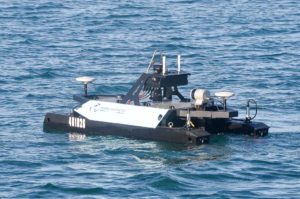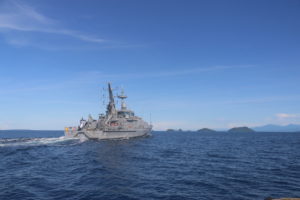By Staff Writer.
The Royal Australian Navy (RAN) is trialling Martac uncrewed surface vehicles (USV) at Exercise Autonomous Warrior 2022 (AW22) this month. Martac and the RAN confirmed the delivery of the USVs to the Navy ahead of the simulated naval battlespace exercise at Jervis Bay.
A Martac representative said the company has sent a T38 MANTAS Devil Ray and T12 MANTAS USV to the RAN via a local supplier. The Australian supplier declined to comment. Martac is a Florida-based company that builds USVs for military, security, commercial and scientific purposes.
The Defence Department says their new USVs, procured through the Navy Capability Division, will serve as technology demonstration platforms to support further development of operating concepts and future capability requirements for the Australian Defence Force “This procurement supports Navy’s Robotic and Autonomous Systems – Artificial Intelligence (RAS-AI) Campaign Plan, which includes an ongoing program of field trials, demonstrations and dynamic displays,” says a Defence Department spokesperson.
“The purchase of these vessels is for early experimentation not for early acquisition of a capability. This experimentation will be used to evaluate different RAS capabilities and develop concept of operations in a range of maritime warfare domains. Experimentation with these vessels commenced at Exercise Autonomous Warrior 22.”

Visiting international defence representatives meet with defence industry professionals from Silvertone to view the Flamingo unmanned air vehicle during Exercise Autonomous Warrior 2022 at HMAS Creswell.
The two-week long AW22 involves around 300 personnel and 40 organisations from the three AUKUS nations. The exercise will evaluate and test some 40 different autonomous systems and technologies, including autonomous vessels, aircraft and vehicles.
“AW22 is an exciting opportunity to showcase the utility and advantages of uncrewed systems in a variety of warfare domains in collaboration with our allies, partners and industry,” says Commodore Darron Kavanagh, the RAN’s Director General of Warfare Innovation.
The super sleek twin-hulled T38 MANTAS Devil Ray USV is 38 feet long, has a cruise speed of 25 knots, a burst speed of 80 knots, and can survive sea state 7, where waves reach 40 feet.

The Maritime Robotics Otter Pro unmanned surface vehicle from Seismic Asia Pacific Pty Ltd operates in the waters of Jervis Bay during Ex Autonomous Warrior 22 at HMAS Creswell, ACT.
“Putting the right equipment on these USVs, designing them for a specific mission, you have a very extensible platform,” said Martac’s Stephen Ferretti at the recent Indo-Pacific expo in Sydney. The Devil Ray is attracting interest from civilian and military customers worldwide, including the US Navy, who trialled the T38 several times last year, including in December in the Arabian Gulf.
Australia’s Defence Department has a well-publicised ambition to test and acquire uncrewed, robotic and autonomous capabilities. Stephen Ferretti says buyers are increasingly interested in the network capabilities of USVs working and communicating together in a swarm but largely independent of human supervision. It’s a significant step up from previous generation USVs which required constant oversight by a remote operator.

The MARTAC Mantis T38 Devil Ray unmanned surface vehicle is craned into the waters of Jervis Bay during Exercise Autonomous Warrior 22 at HMAS Creswell, ACT.
“We’re getting adoption because of the differentiators these USVs bring,” says Mr Ferretti. “Some of the ideas that we’ve talked with potential customers about is having large networks of USVs in the various oceans. They’re coordinated, they’re being controlled, and they’re being tasked to do certain things.
“One potential mission that keeps coming up is marine expeditionary forces. Right now, when you go onto a beach, the expeditionary forces are out there trying to find out what’s in the way of that landing equipment, and that typically involves divers. It involves some pretty nefarious and dangerous things.
“But you can configure one of these USVs with sonar to go out there and do that work for you and take that man out of the danger zone – that’s what these USVs do. If something happens to a USV, it’s just a piece of kit.”
The Australian Navy has been dipping its toes into USV waters for several years now, but typically on a small-scale basis. Per the 2020 RAS-AI Strategy 2040: Warfare Innovation Navy strategy, the Navy views future USVs as complementing rather than replacing crewed platforms.

The MARTAC Mantis T38 Devil Ray unmanned surface vehicle is craned into the waters of Jervis Bay during Exercise Autonomous Warrior 22 at HMAS Creswell, ACT.
“MARTAC USVs are already in service with allied and partner navies, including the United Kingdom Royal Navy and United States Navy,” added the Defence Department spokesperson. “The opportunistic purchase of available vessels through an unsolicited offer allows for collaborative experimentation, innovation and interoperability with close partners with a common platform allowing early achievements of RAS-AI Campaign Plan aims. Using proven systems in use with other navies allows the ADF to engage in early experimentation in USV autonomy and teaming to accelerate Campaign Plan outcomes.”
Coinciding with AW22, the Australian Navy has recently confirmed it was converting the decommissioned patrol boat HMAS Maitland into a USV for remote and autonomous operations. Meanwhile, AW22 and its trial of USVs, including the T38 Devil Ray, will conclude on May 27.

HMAS Maitland on patrol in vicinity of the Shortland Islands in the Solomon Islands.





